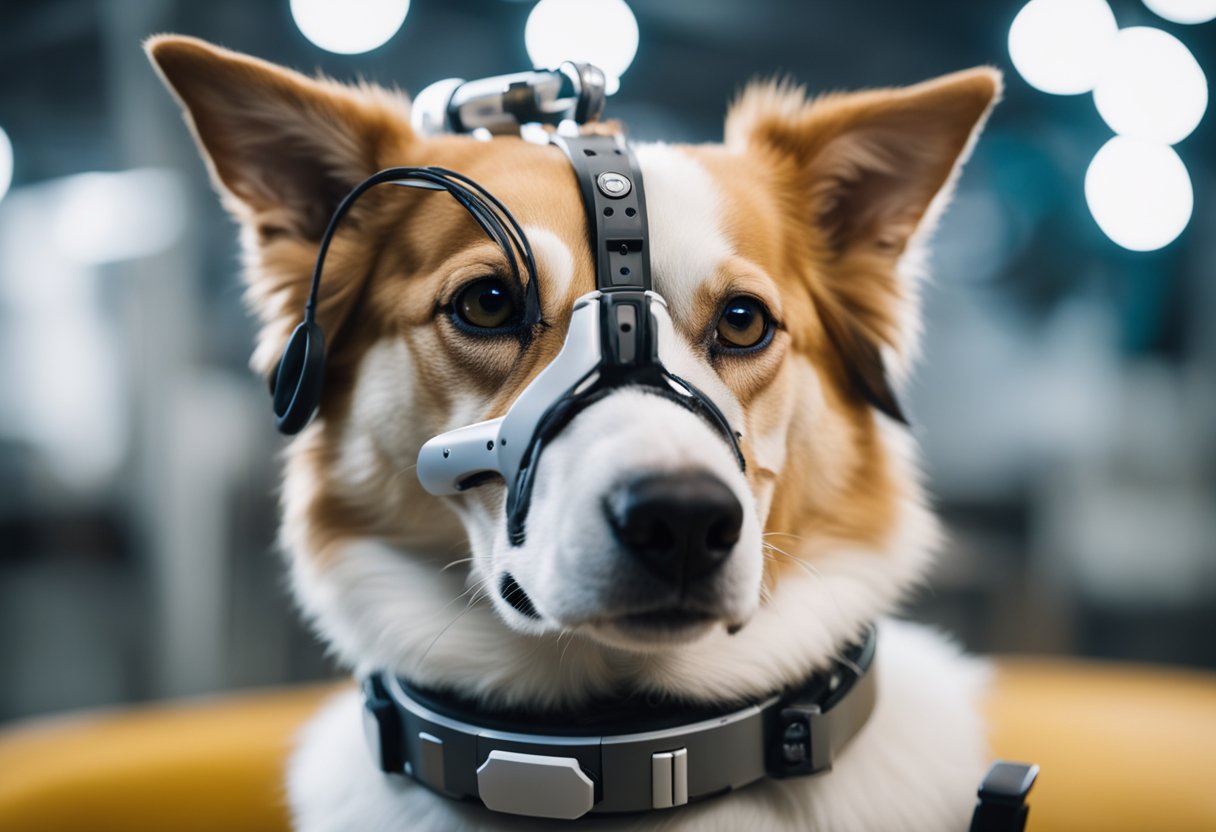Emotional recognition technology is transforming the way we interact with our beloved pets. As we strive to deepen our bond with animal companions, understanding their feelings has become a subject of immense interest. Recent developments in artificial intelligence have made it possible to interpret pets’ expressions and vocalizations, providing insights into their emotions.
Leveraging this technology, we are now able to respond more attentively to the needs and well-being of our pets. By interpreting their behavior through AI-powered systems, we can enhance the quality of life for our furry friends and foster a more empathetic relationship between humans and animals.
Key Takeaways
- AI technology offers a new window into understanding our pets’ emotions.
- Improved responsiveness to pets’ needs enhances their well-being.
- This emerging field promises to strengthen the human-animal bond.
Fundamentals of Emotional Recognition Technology

Have you ever wondered how your fluffy friend might be feeling? We’re diving into the exciting advancements of emotional recognition in pets powered by AI technology. This groundbreaking approach can transform our understanding and deepen our bond with the cherished animals in our lives.
AI and Machine Learning Basics
Artificial Intelligence (AI) and Machine Learning (ML) are the cornerstones of emotional recognition. We often use AI to refer to systems that mimic human intelligence. Within this domain, ML algorithms learn from data, spotting patterns that humans might miss. For instance, they can analyze a dog’s bark or a cat’s meow to derive emotional states.
Understanding Pet Emotions
Pets, much like people, experience a range of emotions. We recognize joy, fear, anxiety, and many more expressions through subtle cues. Facial expressions, body language, and vocalizations convey these emotions. Recognizing these signals through technology requires extensive behavioral research and data that describe what each emotion looks like in different species.
Emotional Recognition Systems
Emotional recognition systems use advanced convolutional neural networks to interpret pet emotions. They examine visual and auditory signals from pets to deduce their emotional states. For instance, software might analyze the facial expressions of pet dogs to determine their mood. Sophisticated AI models can even detect subtleties in pets’ behavior, translating these into emotions us pet owners can understand.
Implementation in Pet AI Technology
As we delve into the intriguing world of Pet AI technology, it’s fascinating to see how emotional recognition algorithms are designed, the cutting-edge hardware employed to detect pets’ emotions, and the innovative ways AI is being integrated into pet products. Through this trio of developments, we are not only understanding our furry friends better but also enhancing the bond we share with them.
Designing Emotional Recognition Algorithms
Designing algorithms capable of understanding pet emotions involves complex machine learning techniques. Sentiment analysis of pets, specifically, relies on robust models like convolutional neural networks (CNNs) to interpret various emotional states. Studies such as those cited in Springer indicate that by analyzing patterns of behavior, voice, and even facial expressions, these algorithms can accurately determine an animal’s current emotional state, ranging from happiness to distress.
Hardware for Emotional Detection
The hardware aspect is crucial in capturing the right data to feed into the algorithms. Specialized sensors, wearable devices, and cameras are typically used to gather real-time data about the pets. Effective emotional recognition may employ thermal cameras to detect heat patterns or microphones to pick up on changes in vocalization, as noted in research on pet dog facial expression recognition. These devices must be non-intrusive and designed to ensure the comfort and natural behavior of pets.
Integrating AI with Pet Products
Finally, we’re seeing a transformative integration of AI technology with pet-specific products. From toys to feeders, AI is being incorporated to not only interact with pets in meaningful ways but also to inform pet owners about their pet’s behavioral and emotional states. For example, AI pet communication tools empower owners to better understand their pets’ needs and enhance overall well-being. Additionally, advancements in pet technology are continuously explored in professional domains, as highlighted by GlobalPETS, marking a new era in the pet care industry.
Applications of Emotional Recognition in Pets
In exploring how AI technology has revolutionized the way we understand our furry friends, it’s clear that emotional recognition is a paramount breakthrough. We’re now capable of taking pet care to new heights, not just by meeting their basic needs, but by nurturing their emotional well-being too.
Enhancing Pet Care with AI
With the advent of AI in animal emotion recognition, we’re able to discern the subtle moods and feelings of our pets beyond what was previously possible. This technological advancement means we can cater to the emotional needs of animals more effectively, leading to happier and healthier pets.
One application is in interactive toys and gadgets, which adjust play based on the animal’s mood, enhancing engagement and providing comfort when needed.
Behavior Monitoring and Wellbeing
Monitoring behavior has always been an integral part of ensuring a pet’s well-being. By integrating AI technology, specifically convolutional neural networks, we’re now able to interpret actions and expressions of pets with notable accuracy. This allows for real-time adjustments in their environment or care routines to optimize their comfort and happiness.
Emotion recognition systems can alert us to changes in our pets that may indicate stress, anxiety, or illness, prompting timely veterinary care. This proactive approach contributes to a higher standard of health and wellness for our animal companions.
Challenges and Ethical Considerations

Advancing AI technology brings fascinating opportunities to enhance the lives of our pets. As we explore these possibilities, we face significant challenges and ethical considerations, particularly concerning the accuracy and reliability of AI and its implications on pet care.
Accuracy and Reliability Issues
It’s crucial for us to acknowledge that AI-based emotion recognition in pets is still in its infancy. While the prospect of understanding our companions on a deeper level is exciting, it’s not without its difficulties. One major challenge is ensuring the accuracy of the technology. For instance, signals interpreted as ‘happiness’ might be misrepresented due to individual differences between pets. There’s also the question of reliability over time and across various contexts; an AI system’s interpretation must consistently reflect true emotions regardless of changes in environment or health.
Ethical Implications of AI in Pet Care
Incorporating AI into pet care naturally leads us to consider the ethical implications. We have a responsibility to question whether the technology truly serves the best interest of our pets. Do these tools improve their welfare, or do they risk infringing on their natural behavior? Some people are concerned about the consequences of misinterpreting an animal’s emotional state, potentially leading to inadequate or inappropriate responses from their human caregivers. There’s also the matter of privacy considerations and respecting the autonomy of our furry friends, topics thoroughly examined in discussions about ethical concerns in emotion recognition technologies.
Future Trends and Research Directions

We’re at the forefront of a significant shift in how we understand and interact with our pets, thanks to artificial intelligence (AI). As research pushes the boundaries of technology, we’re poised to see groundbreaking advancements in AI emotional recognition and novel applications within pet technology that could transform our relationship with our furry friends.
Advancements in AI Emotional Recognition
Recent studies have laid the groundwork for more nuanced emotion recognition systems. AI’s capability to decode subtle emotional cues from animals is rapidly evolving. This progress points towards systems that can better assess and respond to the emotional states of pets, leading to improved animal welfare. Consider the research suggesting comprehensive methods to protect the emotional needs of animals; these possibilities are expanding the horizons of pet care and tech applications. For example, facial expression recognition for pets, like dogs, is gaining traction and could lead to more empathetic interactions between humans and pets.
Potential for New Applications in Pet Tech
The integration of emotion recognition systems in pet technology promises a spectrum of new tools for pet owners and veterinarians. From automated pet monitoring devices that track mood fluctuations to interactive toys that adapt to a pet’s emotional state, the potential for innovation is substantial. Imagine a smart collar that not only tracks your dog’s physical activity but also its emotional well-being — a concept that’s becoming increasingly feasible. Additionally, these technologies have the potential to open up new channels for communication between humans and their pets, enhancing understanding and strengthening the bond we share with our animal companions.
Frequently Asked Questions

We’ve gathered some of the most common inquiries about the intersection of AI and pet emotions and are excited to share what we’ve learned. From understanding our furry friends better to the cutting-edge techniques involved, these questions cover the essentials of emotional recognition in pets through AI technology.
How can AI be used to interpret a dog’s emotional state through facial expressions?
AI leverages convolutional neural networks to analyze subtle changes in a dog’s facial expressions, interpreting these cues to ascertain their emotional state. This can enhance our bond with dogs by fostering greater empathy and understanding.
Are there datasets available for training AI on recognizing dog emotions?
Indeed, datasets curated with diverse images of dogs displaying various emotions exist to train AI models. These datasets are crucial for developing algorithms that can recognize a dog’s emotional cues accurately.
What techniques are commonly employed in AI to discern pets’ emotions?
AI uses techniques such as deep learning and neural networks to interpret a wide range of signals that indicate a pet’s emotional state, including facial expressions and body language.
Can AI assist in understanding the emotional intelligence of animals?
AI has the potential to greatly advance our understanding of animal emotional intelligence, shedding light on the complexity of their emotional lives and strengthening the human-animal bond.
Is it possible for artificial intelligence to accurately predict pet emotions from body posture?
Artificial intelligence is being developed to analyze body posture alongside facial expressions, and some systems have made progress in assigning emotions like happiness or stress based on these physical cues.
How has DeepLabCut been utilized in the analysis of animal emotions?
DeepLabCut, an AI tool for pose estimation, has contributed to emotion analysis in animals by tracking specific body parts, which helps in understanding both subtle and obvious emotional reactions.

